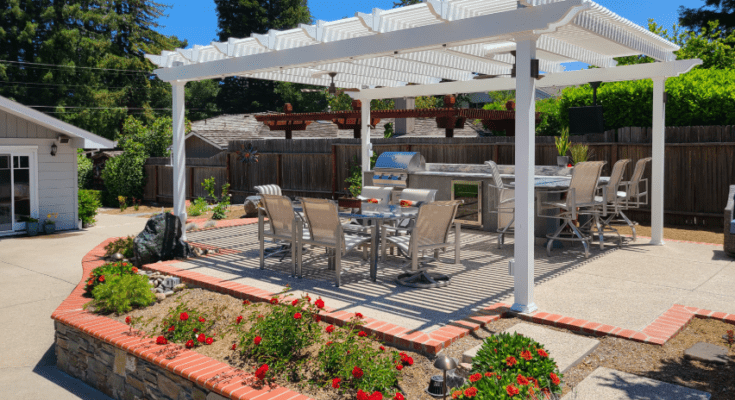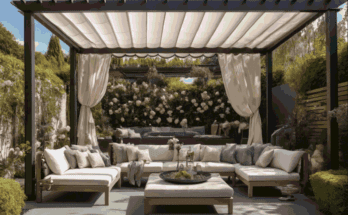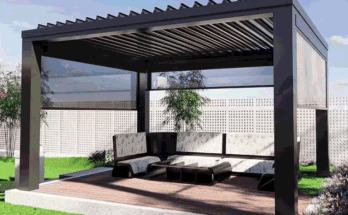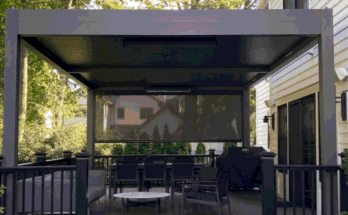1. Introduction
Enhancing your house by adding a free-standing covered pergola is an ideal way to improve your outdoor living area. If you want to introduce a place for relaxation, add some entertainment space, or just convert it to a small place for eating, a pergola definitely serves its charm alongside other practical uses. Without further ado, this article tackles free-standing covered pergolas comprehensively by looking at its advantages, materials, installation, and maintenance.
2. What is a Free Standing Covered Pergola?
A free-standing covered pergola is a structure that is put up in a garden or patio but not affixed to the house. The ‘covered’ part refers to a roof or canopy that can provide some shade yet does not limit or fully restrict aerial ventilation. It creates sheltered space and does not completely obstruct the sight or movement of air.
Key Features:
- Open Design: Unlike a fully enclosed construction, A pergola has an open-air design, where spanning beams or columns allow lights and air to permeate through, thus making the structure spacious and calm.
- Durability: Pergolas are made with robust materials that offer protection against various climatic conditions, ranging from brassy sunshine to sporadic showers.
- Versatility: A pergola can serve as a sun shade, a secluded garden area or even a space to hold gatherings.
3. Benefits of a Free Standing Pergola
Enhancing Outdoor Space:
The addition of a pergola will enrich and beautify the outdoors. A barren yard or patio can be transformed into an appealing dining, reading, or relaxing place. Moreover, it adds more style and value to your exterior space than the current position.
- Increased Curb Appeal: The sight of the pergola installed near your house or garden enhances your outdoor décor. The open structure style enhances your outdoor architectural design and could be a great centrepiece.
- Versatile Outdoor Space: A pergola enables you to maximize your outdoor space in your backyard, such as using it to read or host barbecues in the summer.
- Protection from the Elements: Since a pergola doesn’t provide full cover during scorching afternoons but offers enough shade, it makes all outdoor activities comfortable all year round, especially during light showers.
4. How to Choose the Right Location
When deciding on the location for your solar pergola installation, ensure you have the right location. Here are some tips to help in choosing the best site for a solar pergola:
- Sunlight Exposure: The ideal location for a solar pergola should neither be too shady nor too bright. It would help to consider the sun’s angle in the summer or winter. For example, it can be placed to the west to get shade in the evening sun.
- Space: A solar pergola should also be sufficiently far from the house and not dominate your garden area, so there is still space around it to walk.
- Proximity to the House: Although a pergola can exist independently, having it closer to the house will make entering more convenient. If you intend to use it for outdoor meals or parties, you might want to place it near the kitchen or the living room.
5. Types of Pergola Roof Designs
Light structures with pillars and crossbeams are also called pergola support beams. The top of a pergola frame can be in many different styles according to an individual’s needs, and each design has its unique benefits.
- Louvred Roof: Louvered roofs have slats that rotate on an axis, allowing one to determine the amount of Sun exposure desired. If someone wants to control the slats, then this type of covering is ideal.
- Gabled Roof: A type of triangular, gabled roof which enhances the beauty of a building. It is quite often used for gabled buildings, especially when the house has gabled roofs.
- Flat Roof: A flat roof is ideal for those who prefer minimalism. It offers a perfect modern touch and also provides ease without the frustration of troubleshooting sloping roof features.
- Thatched Roof: A more traditional rustic or tropical style usually constructed with straw or reed. This is an excellent option if you wish to have a lush feel to your backyard!
6. DIY vs. Professional Installation
The choice between installing the pergola yourself or hiring a professional depends on your experience and the complexity of the project:
Pros of DIY:
- Cost-Effective: The major benefit of DIY is spending less money. You only need to purchase the materials without the added labour expenditure.
- Personal Satisfaction: There is a unique fulfilment in creating something from scratch. This feeling makes it appealing to people with the right equipment and skills necessary for the task.
Cons of DIY:
- Time-Consuming: Depending on your experience, working to construct a pergola can take anywhere from a couple of days to several weeks to complete. This can be demoralizing if you have little experience with construction.
- Risk of Mistakes: There is a potential risk of structural errors, which can lead to incurring more costs in the future. This is mostly due to a lack of professional knowledge.
Pros of Professional Installation:
- Expertise: Someone who can install professionally ensures that everything is done right and according to the area’s codes.
- Time-Saving: If you are working with time restraints, it may be important to have professional installers as they get the job done quickly.
7. Materials for Building a Pergola
The type of materials for your pergola determines its strength, looks, and the attention it requires to maintain. Here’s a breakdown of materials in common:
- Wood: Considered a classic, it is often chosen due to its rich natural colour. Cedar and redwood are two of the most common options, which provide an inviting touch and withstand weather effects quite well. Pressure-treated pine is also quite favoured as it is not expensive.
- Metal: Steel and aluminium pergolas are strong, lightweight structures that require little maintenance. While steel is extremely durable and can support large roofs, aluminium does not rust.
- Vinyl: This is a great option for people who want an easy-to-maintain option, as vinyl pergolas do not require painting or sealing. However, they lack the rustic feel earned by wood and the sturdiness of metal.
8. Installing a Pergola Next to Your House
Constructing an attached stand-alone pergola in your perfect home is not that difficult if you follow the right guidelines:
- Planning: Carefully consider the size and angles of the area around the pergola before measuring the area.
- Preparation: Depending on what is needed, the soil will be prepared by levelling the ground and cleaning any rubbish or other obstructions that could be in the way. A gravel or cement footing foundation will be poured for permanent attachment or stability if necessary.
- Construction: First, construct the frame and cement all the beams and posts. Then, the roof structure, whether slats or a complete cover, can be fitted.
- Finishing: After finishing the basic structure, all needed elements can be put into place including lighting appliances, creeping plants or even cushions to personalize it.
9. Pergola Designs to Match Your Home
The construction of the pergola must be consistent with the basic style of the house. Widely, there are tuna types which are modern, rustic, and classical and appropriately designed to fit into the already existing ones perfectly:
- Modern Design: The optimal option combines a clear metal construction with an ornamental minimalist design.
- Rustic Design: Reclaimed wood and untreated lumber mix provides a country-style appeal.
- Mediterranean Design: Columns or terracotta roofs can be ushered in on Mediterranean or coastal homes or all homes designed in this style.
10. Maintenance and Care for Pergolas
The care your pergola receives depends on the material employed.
- Wood Pergolas: Stains or sealants, which should be applied at least once a year, can prevent rot and decay. Always check the structure for termites and damage.
- Metal Pergolas: Wipe the metal with a damp cloth to prevent rust, and use paints whenever needed.
- Vinyl Pergolas: To wash the structure and prevent it from looking rough, all that is necessary is soapy water and a soft brush.
11. Creating the Perfect Outdoor Ambience
What your pergola becomes in terms of creativity and function will help convert it from being a mere structure, so here are some ideas:
- Lighting: Using lights will completely change the vibe of your pergola, so it would be best to put in some string lights or lanterns if you plan to keep it modestly bright. Integrated LED lights can also be installed on beams or under the pergola’s roof for a more modern setting.
- Furniture: Adding outdoor sofas, lounge chairs, and a hanging swing will encourage comfortable seating in the space, further aiding the structure’s positioning. If you plan to have guests over for meals outside, include a dining table and chairs.
- Greenery: Adding plants can elevate the ecosystem. Think about using hanging pots, miniature flower gardens, or beautiful climbing plants that can be trained to twine around the pergola to create a neat, green look. Jasmine, Wisteria, and Ivy are well-known.
12. Pergolas and Landscaping
A pergola is most functional when combined with other landscape architecture elements. Here are ideas on how to blend it to your garden or yard:
- Flowering Vines: Flowering vines, such as wisteria, clematis, or even roses, can be planted around the pergola and trained to grow around it to form a beautiful and colorful canopy.
- Pathways: Build a stone or gravel path that encircles the pergola and paves the way to the desired location. This will make a good impression and direct the audience towards your garden sanctuary.
- Water Features: Placing a fountain or a water basin not too far from a pergola can add a soothing effect to the atmosphere of the exterior setup. The sound of water complements the already tranquil ambience that a pergola provides.
13. Cost of a Free Standing Pergola
Before launching any work, it is important to understand how a pergola installation will cost you. Its cost range is quite wide depending on the materials, size, and whether you are building it or getting a contractor to do it:
- Wood Pergolas:The cost of wood pergolas typically ranges between $2,000 and $5,000, depending on the type and size of the wood. Cedar and Redwood are on the higher end of the spectrum, while pressure-treated pine is relatively cheaper.
- Metal Pergolas: A great alternative, but at a cost between two thousand five hundred dollars to six thousand dollars, are metal pergolas, which are painted in a modern fashion. Steel is a nice choice because it is durable, aluminum on the other hand offers cost benefits and does not rust.
- Vinyl Pergolas: Priced between $1500 and $4000, vinyl is a good option because it is also low-maintenance and costs less than wood and metal. However, it may not give the exact aesthetic feel of natural wood.
- Installation Costs: If you hire professionals, labour costs will add about 20-30% to the overall price. DIY projects can save on this, but consider your time and skill level.
15. Conclusion
A free-standing covered pergola next to your house is an investment in aesthetics and functionality. Whether looking for a stylish outdoor dining area, a place to relax with family, or a garden feature, a pergola checks all the boxes. It enhances the appearance of your outdoor space and provides a versatile area to enjoy nature while being sheltered from the sun or light rain.
Building or installing a pergola is a worthwhile project that can significantly improve your backyard, providing beauty and comfort for years to come. So, what are you waiting for? Plan your perfect pergola today and transform your outdoor experience!
FAQs
[saswp_tiny_multiple_faq headline-0=”h3″ question-0=”Am I required to apply for a permit in order to construct a free-standing pergola?” answer-0=”It depends on the building regulations in your local area. In many regions, if the pergola meets certain heights or is situated at or close to property boundary lines, a building permit may be required. Always check with local authorities in your area before starting.” image-0=”” headline-1=”h3″ question-1=” What is the life expectancy of a pergola?” answer-1=”The life expectancy of construction is determined mainly by the materials applied and the maintenance practices deployed. For instance, if a timber construction pergola is well maintained, it can survive for 10-15 years. However, metal and vinyl pergolas with minimal maintenance can last over 20 years.” image-1=”” headline-2=”h3″ question-2=”Is it possible to place a roof on my pergola?” answer-2=”Yes. Many pergolas are made such that a roof can be incorporated on top of them. You can add an adjustable roof or a slatted roof to the structure, which offers the versatility to manage the level of sun or rain intrusion the space gets.” image-2=”” count=”3″ html=”true”]




